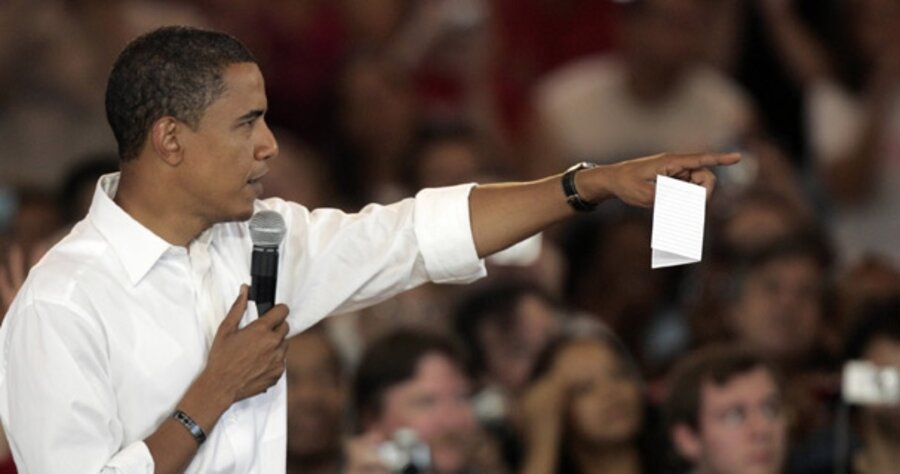How the 2008 electoral map has changed
Loading...
| Washington
Flush with cash, Democrat Barack Obama has spent months trying to expand the battleground in the 2008 presidential elections. Ad buys in normally Republican states like Montana, North Dakota, and Alaska signaled a bold effort to turn the usual 10-or 11-state map of swing states into a 20-state contest.
Now, following a whirlwind two weeks of back-to-back conventions and a stunning vice presidential pick by Republican John McCain, both nominees have consolidated their bases of support. And the likelihood is that, with a few exceptions, the 2008 battleground will look similar to 2004.
“We’re probably talking about a race that is very much about the Great Lakes and Mountain West regions,” says Evan Tracey, a political media specialist and founder of Campaign Media Analysis Group in Arlington, Va.
Demographic shifts have nudged traditionally Republican Colorado and Virginia onto the map, with the campaigns planning plenty of appearances in both states. But a look at the 11 states in 2004 that were decided by a margin of victory of fewer than 6 points provides a basis for assessing 2008. Of those 11 states, Democratic nominee John Kerry won six: New Hampshire, Pennsylvania, Michigan, Wisconsin, Minnesota, and Oregon. President Bush won New Mexico, Nevada, Iowa, Florida, and Ohio.
In 2008, Oregon is on no one’s list of battlegrounds, and is expected to go for Obama. Of the others, pundits disagree on the degree to which various states are in play. Michigan, for one, with its deeply struggling economy, should be in the Democrats’ back pocket, but Senator McCain has played well there in the past. Same goes for Pennsylvania.
McCain’s choice of Alaska Gov. Sarah Palin, a cultural conservative with a charismatic persona, could help the GOP ticket in the rural portions of those two states. But the degree to which independent and swing voters are receptive to her persuasion remains uncertain.
“Rural Pennsylvanians are Republican,” says Byron Shafer, political science chair at the University of Wisconsin. “Republicans are going around scooping up Republicans. In order to carry Pennsylvania, you have to win a big chunk of the Hillary vote.”
In the end, he adds, it’s a stretch to see many supporters of Sen. Hillary Clinton, who beat Obama soundly in Pennsylvania’s Democratic primary, being swayed by Governor Palin, whose policy positions hold little in common with Clinton’s.
Florida, the final battleground of 2000, is another question mark in 2008. Susan MacManus, a political scientist at the University of South Florida in Tampa, views her state as still very much in play. Democrats have the edge in voter registration, but she discounts self-identified Democrats in the Panhandle, since many vote Republican for president. So essentially, voter registration is even there.
McCain’s military profile makes him strong in Florida, which has a large active and retired military presence. But South Florida remains a Democratic stronghold, with a large Hispanic population and many transplants from the Northeast.
Still, Mr. Tracey, the media analyst, notes that Obama has spent millions of dollars in Florida – $9 million from mid-June to right before the conventions – “without moving the needle.” It’s possible that, without such spending, Obama would have fallen behind in Florida, but as Election Day gets closer, he will have to decide where he gets the best value for his money.
“Obama is up in the Tampa and Orlando markets,” says Tracey. “Those are the biggest undecided markets in the state. But obviously, if you’re trying to win a state, you need more than those markets.”
The most intriguing battleground, in some ways, is Virginia, which has gone from solid R in the presidential race four years ago to a toss-up on many pundit lists – the result of a population explosion in the moderate northern Virginia suburbs of Washington, D.C.
Four years ago, the state had two Republican senators. Now, it has one Democratic senator, Jim Webb, and looks likely to elect its second, former Gov. Mark Warner. Those two men, plus popular Democratic Gov. Tim Kaine, give the state’s Democrats a sense of momentum.
Independent pollster John Zogby is looking to Virginia as a possible bellwether in November. Right now, the average of major polls, as calculated by RealClearPolitics.com, shows an absolute tie in Virginia between Obama and McCain.
“If either candidate starts to pull away in Virginia, and we get clarity in Virginia, we’ll get clarity in a lot of those other states,” says Mr. Zogby.
Another big factor heading into the fall is money. Obama is not taking federal financing, and his funding juggernaut has shown no signs of slowing. When McCain announced Palin as his veep pick – a move to court conservatives that alarmed the Democratic base – millions of dollars flowed into Obama’s coffers overnight.
McCain is sticking with the federal presidential funding program, which limits the amount of money at his disposal. If the Republican Party and sympathetic independent groups can make up the slack, McCain may be able to match Obama’s ads in key states. But if not, Obama could outgun McCain in the battlegrounds, and push him back in some of the outlying states he is still hoping for, such as Georgia and North Carolina.
By the end of this week, says Tracey, as the race settles down from the conventions, the battlegrounds should be clear. But for now, with the overall horse race showing Obama up by an average of fewer than 2 points, this one is too close to call.





